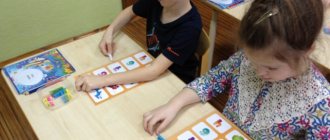The use of outdoor games in the pedagogical process presupposes strict adherence to the didactic principles of accessibility, systematicity, sequence of activity, and awareness. For each age group, games must be selected in accordance with the principle of the predominant type of movement: walking, running, throwing, jumping or climbing.
In pedagogy, outdoor games are widely used, in which, in addition to the basic movements, others are used, for example, rhythmic clapping, stamping, etc. When conducting them, the teacher can pursue different goals depending on the stage of the children’s physical development. Advanced Russian scientists P.F. Lesgaft, E.A. Pokrovsky, V.V. Gorinevsky, taking into account the important role of outdoor games in the development of a child’s physical strength and in acquiring certain skills, paid a lot of attention to the collection and study of such games. They explained their importance for the physical development of children and advocated their practical implementation in the system of education of the younger generation. Subsequently, these progressive ideas were reflected in the works of scientists who developed the theory and methodology of outdoor games in different parts of the physical education system.
Outdoor play is a natural companion in a child’s life, a source of joyful emotions that has great power.
Outdoor games are a traditional means of pedagogy. One of the characteristic features of outdoor games is the desire for results. The child experiences joy from satisfying the need for movement, from the emotional atmosphere of the game; a special emotional upsurge is caused by the achievement of a real, visible positive result - winning. The variety of outdoor games has long led researchers and compilers of collections to the need to group games and classify them. The study of outdoor games for preschoolers was carried out by such teachers as L.I. Chulitskaya, E.A. Arkin, M.M. Kontorovich, N.A. Metlov, L.I. Mikhailov, and later V.M. Boguslovskaya, A.I. Bykova, A.I. Sorokina, E.G. Baturina, N.G. Kozhevnikova, N.N. Quilpio et al.
Classification of outdoor games for preschoolers
Games are classified according to complexity, motor content, degree of physical activity, use of aids and equipment, and the primary formation of physical qualities. In the “Kindergarten Education Program” and in existing collections of outdoor games, the classification is based on the sign of the predominant type of movement (running or jumping, throwing, climbing, etc.). When selecting for each type of basic movements, continuity between age groups is observed. This helps the teacher plan games in connection with the formation of certain motor skills in children. In the collection M.M. Kontorovich and L.I. Mikhailova , it is customary to divide games according to the degree of muscle tension caused in children: into games of large, medium and low degrees of mobility. High mobility - the whole group participates (running, jumping, "Traps", "Tags") medium mobility - the whole group actively participates, but the nature of the movements is relatively calm (walking, passing objects) low mobility - movements are performed at a slow pace, moreover their intensity is not significant (walking game, attention games, “sea figure”, “Find and remain silent”).
Outdoor games are varied in their content and organization. Some games have a plot, roles, and rules that are closely tied to the plot; game actions in them are carried out in accordance with the requirements, given role and rules. In other games there is no plot and roles; only motor tasks are offered, regulated by rules that determine the sequence, speed and dexterity of their implementation. Thirdly, the plot, the actions of the players are determined by the text, which determines the nature of the movements and their sequence.
All games for preschool children based on movement can be divided into two large groups: outdoor games with rules and sports games . The first group consists of games that differ in content, in the organization of children, in the complexity of the rules and in the uniqueness of motor tasks. Among them are plot and plotless games, and fun games. The second group is sports games: gorodki, badminton, basketball, table tennis, football, hockey. When working with preschool children, they are used with simplified rules. In the younger groups of kindergarten, the most widely used are plot-based outdoor games , as well as simple games without a plot, such as traps and fun games. Plotless games with elements of competition, relay races, games with objects (kids, skittles, ring throws, serso, etc.) are not yet available to children. Sports games are not played at all at this age. At the same time, when working with children of primary preschool age, play exercises are widely used, occupying an intermediate place between gymnastic exercises and outdoor games.
LIST OF REFERENCES USED
- Vetkov N.E. Sports and outdoor games: educational and methodological manual / N.E. Vetkov, Orel: MABIV, 2016. - 126 p.
- Mendot E.E. Outdoor games as a means of harmonious development of children / E.E. Mentod, Bulletin of TuvGU, 2011. – p. 116-120.
- Sageeva G. History of the emergence of outdoor games and their role in the process of physical education /. Modern trends in the formation of the educational environment of a technological university. Intl. scientific method. conf.: 2022. - p. 204-205
- Smolin Yu.V. Fundamentals of the theory of sports competitions and outdoor games / Yu.V. Smolin. Chelyabinsk: ChGIK, 2016. - 56 p.
- Nurgalieva R.Kh., Latipova M.R., Kamalova E.I. Outdoor games in the system of physical education as an element of the education of national culture: Educational and methodological manual / Almetyevsk: AKFK, 2012. - 108 p.
Examples of the outdoor game “Hawks and Swallows”
An unlimited number of players can take part in this game. The latter are divided into two groups and form two rows, standing with their backs to each other. There will be hawks in the first row, swallows in the second row. One player is chosen as the leader. The latter walks between the players of both rows and says abruptly the words: yas...requirements or las..., but does not pronounce the end of the word. The group whose name the leader pronounces in full must run away in different directions, the players of the unnamed group must catch up with them. Players who are caught become members of the catching team.
- Social protection program and legal framework
- Social protection program and legal framework (Faculty: Law)
- The main stages of prepress preparation of multipage publications
- Bauhaus and Art Nouveau
- Font and Typography (FONT)
- History of the development of track and field sports (separately for each type of athletics for men and women) (Concept and general characteristics of track and field sports)
- History of the emergence and development of outdoor games (History of the emergence of outdoor games)
- Methods of conducting a lesson using information technology and Internet resources
- Theory and methodology of outdoor games (Theoretical prerequisite for the development of the game.)
- Educational Internet resources (Structure of the Internet)
- Outdoor games with basketball elements, characteristics and meaning.
- Outdoor games with basketball elements, characteristics and meaning
Plotless outdoor games
Plotless games such as traps and dashes are very close to plot ones - they just don’t have images that children imitate, all other components are the same: the presence of rules, responsible roles (traps, tags), interconnected game actions of all participants. These games, like the story ones, are based on simple movements, most often running combined with catching and hiding, etc. Such games are available to both younger and older preschoolers.
Plotless games require children to be more independent, quick and dexterous in their movements, and spatially oriented. Gradually the games become more complex, with more complex tasks.
Game exercises
Outdoor games and exercises are interrelated, however, in terms of purpose, pedagogical objectives, content and methodology, the game and exercise are not identical. An outdoor game is based on a certain concept (figurative or conventional). Exercises are methodically organized motor actions, specially selected for the purpose of physical education, the essence of which is to perform specific tasks (“Crawl to the rattle”, “Hit the goal”, etc.).
Let's summarize this work
In the first section, the basic concepts of outdoor games were examined, and the opinions of several teacher-researchers on the emergence and origin of games were considered. The second section of the essay is devoted to the development of outdoor games: their relationship with geographical and ethnic characteristics was examined, the types of games, the reasons for their modification and transformation among different nationalities, as well as over time, were determined. The third paragraph touched upon the problem of reducing the activity of modern children and adolescents. The use of outdoor games in physical education lessons is considered. We can conclude that outdoor games were of great importance at all times of the formation and development of society: from primitive communities to the present.
Games with competitive elements
(“Whose line will be most likely to line up”, “Who will be most likely to go to their flag”, etc.). These games are based on performing certain motor tasks in accordance with the rules. Elements of competition encourage children to be more active, to demonstrate various volitional and motor qualities (speed, endurance, etc.) Games are available to older children (5–6 years old); they are not played in younger groups. Games with elements of sports games - are held only with children of senior preschool age according to simplified rules (small towns, badminton, hockey, basketball, etc.). Outdoor games , like other types of games, are a form of organizing children’s lives and are of great importance in developing communication skills and developing relationships between children in a kindergarten group. This point is especially important nowadays, when most children, for safety reasons, are deprived of the opportunity to participate in yard games, which until recently were a good educational school. Effective development of the physical qualities of children of primary preschool age is possible if a methodology is developed and used, including:
- Purposeful use of a system of outdoor games, focused on the development of certain physical qualities (speed, agility, speed, etc.).
- A more expanded scope of outdoor games compared to the traditional method.
Properly organized outdoor games can act as a way to correct children’s relationships, contribute to the development of positive qualities, and are a means that can have a positive impact on relationships with peers of middle preschool children. To solve the problem, it is necessary to use outdoor games in educational activities, since they can turn a lazy person into a hard worker, and a know-nothing person into a skillful person. Outdoor games were included in various forms of physical education such as: physical development classes, outdoor and indoor exercises, morning exercises, walks, etc.
At each physical development lesson, we used outdoor games of a different nature: large, medium and low mobility. Most often, games of a plot nature were used, since the plot captures the child’s attention, and emotions are most clearly manifested in them. To create children's interest in the game, we introduced masks into the games and turned on music. In relay games, various objects were used: jump ropes, rope, balls, skittles, etc. The feeling of joy in children was especially pronounced when the games were accompanied by music , since music affects children’s emotions and creates a certain mood in them. We used games to music during morning exercises and invigorating exercises. In the game “Entertainers,” we developed the expressiveness of movements in children, so that they felt relaxed, showed movements both with humor and with different emotional states. To do this, we used verbal image cues: Smile like: a cat in the sun; like Pinocchio; like a sly fox; as if you had seen a miracle. Get angry like: a child whose ice cream was taken away; like a person who has been hit. Be scared like: a child lost in the forest; the hare who saw the wolf; a kitten at which a dog barks. You are tired, like: dad after work; a person lifting a heavy load; an ant dragging a big fly. Relax like: a tourist who has taken off a large backpack; a child who worked hard but helped his mother. It was difficult for children to show these emotions at first. They didn't understand what we wanted from them. Children are very fond of outdoor games, where imitative movements are repeated simultaneously with words.
Examples of outdoor games
In the game “Homeless Hare,” children performed the movements of hares: they jumped onto the meadow, had fun, danced, waved their paws, and sang songs. One student was so busy doing the moves that she forgot about the fox and was very surprised and confused when she was left without a house. When playing the game again, we reminded her about the fox. She was very pleased when she managed to occupy the house. We developed the emotions of surprise, fear, anger, pity in the game “Geese and the Wolf” . In order to unite the children's team, we use group games (especially team games) to unite players with a common goal - victory in the competition. Team members will help each other quickly complete the task you set, and after the game the children will discuss their impressions and share their emotions for a long time. In the process of physical education of children of primary preschool age, outdoor play plays a leading role. Being one of the main means and methods of physical education, outdoor play allows you to effectively solve health-improving and educational tasks. It has a comprehensive impact on the physical development and health of the child. During the game, the motor activity of children causes an active state of the whole organism, enhances metabolic processes, and increases vitality. In the process of play activities, children develop moral and volitional qualities, develop cognitive powers, and gain experience in behavior and orientation in a group environment. An active game with rules is a conscious, active activity of a child, the goal of which is achieved by accurate and timely completion of tasks related to the rules that are mandatory for all players. According to the definition of P.F. Lesgaft, outdoor play is an exercise through which a child prepares for life. The exciting content and emotional intensity of the game encourage certain mental and physical efforts. Play can be a means of self-knowledge, entertainment, relaxation, and a means of physical and general education. Play is a very emotional activity, so it is of great value in educational work. Among the wide variety of games in the formation of a child’s diversified personality, outdoor games are given the most important place. The importance of outdoor games is great: they are both a means and a method of raising a child. Outdoor play as a means and as a method is characterized by a variety of effects on the child due to physical exercises included in the game in the form of motor tasks. In outdoor games, various movements are developed and improved in accordance with all their characteristics, the characteristics of children’s behavior and the manifestation of the necessary physical and moral qualities are directed. With the help of outdoor games, you can solve various problems of moral, mental and, of course, physical education. As Shapkova L.V. notes, “with hypokinesia (inactivity) in children, the activity of biochemical processes decreases, immunity to colds and infectious diseases weakens, the range of capabilities of the respiratory and cardiovascular systems narrows, the neuromuscular system weakens, various postural defects form, which leads to muscle hypotonia, decreased mobility of the chest in all its parts, general weakening of the body and decreased vitality. A characteristic consequence of these disorders in the functioning of various systems and organs is the deterioration of physical and psychomotor qualities: coordination, accuracy and speed of movements, speed of motor reaction, mobility and general performance.” Taking into account the age characteristics and physical fitness of those involved in outdoor games, they have a beneficial effect on the growth, development and strengthening of the musculoskeletal system, the muscular system, on the formation of correct posture in children, and also increase the functional activity of the body. Active motor activity of a playful nature and the positive emotions it evokes enhance all physiological processes in the body, improve the functioning of all organs and systems. A large number of movements activates breathing, blood circulation and metabolic processes. This in turn has a beneficial effect on mental activity. It has been proven that outdoor games improve the physical development of children, have a beneficial effect on the nervous system and improve health, because Almost every game involves running, jumping, throwing, balance exercises, etc. The game plays a big role in the formation of personality. During the game, memory and ideas are activated, thinking and imagination are developed. During the game, children act in accordance with the rules, which are mandatory for all participants. The rules regulate the behavior of the players and contribute to the development of mutual assistance, collectivism, honesty, and discipline. At the same time, the need to follow the rules, as well as overcome obstacles inevitable in the game, contributes to the development of strong-willed qualities - endurance, courage, determination, and the ability to cope with negative emotions. Children learn the meaning of the game, learn to act in accordance with the chosen role, creatively use existing motor skills, learn to analyze their actions and the actions of their comrades. Outdoor games are often accompanied by songs, poems, counting rhymes, and game starters. Such games replenish vocabulary and enrich children's speech. In outdoor games, the child has to decide for himself how to act in order to achieve the goal. Rapid and sometimes unexpected changes in conditions force us to look for more and more new ways to solve emerging problems. All this contributes to the development of independence, activity, initiative, creativity, and intelligence. Outdoor games are of great importance for moral education. Children learn to act in a team and obey common requirements. Outdoor play is collective in nature. The opinion of peers is known to have a great influence on the behavior of each player. In a collective outdoor game, each participant is clearly convinced of the benefits of common, friendly efforts aimed at overcoming obstacles and achieving a common goal. The main task of outdoor games is to strengthen the health of those involved and promote their proper physical development; promote the acquisition of vital motor skills and abilities and improvement in them; development of reaction, development of dexterity, knowledge of movement and new capabilities of the body. To implement the tasks, it is necessary to apply the following methods:
- Analysis of theoretical and scientific-methodological literature on the research topic;
- Pedagogical supervision;
- Questioning.
Theoretical analysis and synthesis of literature involves a search for literary sources, which was carried out in libraries, materials from magazines, collections of scientific papers, other scientific and scientific-methodological publications were analyzed, and Internet resources were also used. Many researchers recommend including outdoor games in physical education classes at preschool educational institutions and in children’s daily lives. The practical significance lies in the possibility of using the proposed outdoor games for physical development with children. Having mastered the general tasks of education, we apply them taking into account the individual characteristics of each child. To do this, we used medical examination data for all indicators in order to know which of the children had deviations from the norm of physical development. For the first time, work days analyzed the state of children's motor skills, as well as their overall level of development.
We outlined specific tasks for each child. Children who are timid and unsure of their movements need help in overcoming difficulties: lower the rope lower when jumping, place the basket closer when throwing a ball, support them for balance while walking, etc. But this must be done unnoticed so that the child’s self-esteem does not suffer. Children are easily excitable, overly active and also require attention; we often involve them in games that contribute to the development of inhibitory processes. We carefully analyze an unfamiliar game, mentally play it and only after that offer it to the children. We also first think through where it would be more appropriate to hold this or that game: indoors or on the site. Methodological literature usually recommends learning new games in class. But this can also be done during play hours, for example during a morning walk, when children and the teacher have enough time at their disposal. In order for this work to be systematic in each group, so that not a single child falls out of attention, outdoor games are included in the long-term plan of educational work, as well as in the plan of work for every day. It should be noted what outdoor games will be played with the whole group, what games he will organize with a group of children, and which he will offer to individual children. With the help of the game, the head of physical education or teacher carries out several tasks: strengthens, heals the children’s body, develops movements, causes joyful experiences, develops moral qualities, etc. When including a particular game in the plan, the teacher must know what qualities and skills he can develop and consolidate with its help: in one game running predominates, and in another - throwing, in one - endurance is required from children, and in another - agility, etc. When choosing a game, the teacher should keep in mind where he assumes to carry it out: indoors or on the site.
When selecting games, seasonality is also taken into account. In the summer, when children live among nature, you can use games such as “Catching Butterflies”, “Frogs and Heron”, etc. For winter time, you need to select games in which you can use specific winter materials - snow banks for jumping and balance, snowballs for throwing, etc. When planning games, the teacher should take into account the state of the group. In the case where the group is not sufficiently organized, it is better to initially conduct quieter games in a circle, games with singing, gradually moving on to games with scattered movement, or give simple games. When choosing a game, the teacher takes into account its place in the daily routine; for example, at the end of the day, when the children are already tired, he plays a quieter game. When selecting games for classes, in addition to general educational tasks, you have to especially take into account the hygienic side of each game - the degree of its load, the impact on physiological processes. The choice of game for a lesson depends on which part of the lesson it is included in. If the game is given in the first part of the lesson, it is introduced in order to organize a children's team, teach children to line up in a column, in pairs, in a circle, and place themselves on the playground. These are, for example, the games “Whose team will get together sooner”, “Find yourself a mate”, etc. In the second part of the lesson, a high mobility game is played. For the final part of the lesson, a game of medium or low mobility is selected, the goal of which is to bring the body to a relatively calm state. You can use the following games for this: “Who left?”, “Guess by the voice,” “Find where it’s hidden.” Most often, one, sometimes two games are given in a lesson. For example, one game is included in the second - the main part of the lesson (required), another - in the final one. Outdoor games, creating an atmosphere of joy, make the most effective complex solution to health, educational and educational problems. Active movements, determined by the content of the game, evoke positive emotions in children and enhance all physiological processes.
Children’s play activities objectively combine two very important factors: on the one hand, children are involved in practical activities, develop physically, and get used to acting independently; on the other hand, they receive moral and aesthetic satisfaction from this activity and deepen their knowledge of their environment. All this ultimately contributes to the education of the individual as a whole. Consequently, outdoor games are an effective means of diversified development.
INTRODUCTION
Play contributes to the physical, mental, aesthetic and moral development of the child and is one of the key means of physical education for children of any age. Various movements of children during play have a positive effect on the activity of the cardiovascular and respiratory systems, and also strengthen the nervous system, the musculoskeletal system, improve metabolic processes in the body, promote sound sleep, etc.
Outdoor games ensure the comprehensive physical development of the child. During the game, preschoolers develop and improve various skills in running, jumping, climbing, etc.
A sharp change in the environment during the game requires children to use movements known to them in accordance with different situations. All of the above has a positive effect on improving motor skills.
Play is the first activity that plays a huge role in the formation of personality. Based on the above, we will formulate the relevance of this topic.
Children, like adults, learn about the world through activity. In outdoor games, the ability to correctly assess temporal and spatial relationships is developed, to quickly and correctly respond to the current situation in the frequently changing environment of the game. Outdoor games played on the ground in summer and winter conditions are of great educational importance: at recreation centers, in pioneer camps, on excursions and on hikes.
Outdoor games play an important role in developing physical qualities: speed, strength, endurance, agility, flexibility, and also instill in children a sense of solidarity, responsibility and camaraderie. The rules of the game develop discipline, endurance, the ability to “pull yourself together” and restrain your selfish impulses.
The relevance of the topic lies in the importance of outdoor games in the formation of physical, moral, mental and cultural components in different times: from primitive times to the present.
The practical significance of the work is to clearly show the importance of outdoor games at different stages of the development of civilization.
The object of the study is outdoor games.
The subject of the study is the history of the emergence and development of outdoor games.
Research methods : method of analysis and synthesis.
The purpose of this work is to study the history of the emergence and development of outdoor games.
To achieve this goal it is necessary to complete a number of tasks :
- Consider the history of the emergence of outdoor games;
- Analyze the development of outdoor games
- Consider outdoor games now
Structurally, the work consists of an introduction, three sections, a conclusion, a list of references and an appendix.







